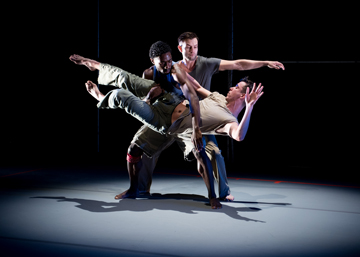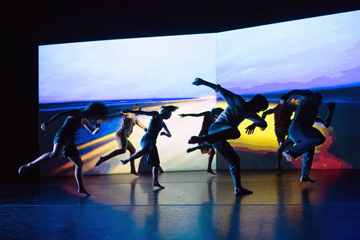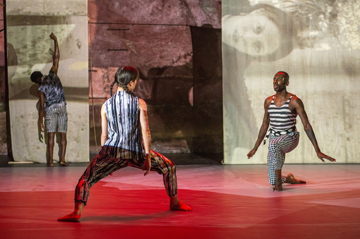Dance: Dance as Catalyst: Three at BAM
By Dawn Lille
arttimesjournal December 23, 2016
These are worrisome, divided, and unsettling times for America and the world. Nationalism and hate are coming to the fore, empathy and humanity appear to be vanishing, and artists in this country are wondering if any art will survive the next few years. The Next Wave Festival at the Brooklyn Academy of Music (BAM) often jumps ahead with ideas and questions. Three noteworthy performances this fall season touched on these issues in different ways.
Pavement— Kyle Abraham/Abraham In Motion
 Pavement by Kyle Abraham. photo by Ian Douglas |
Pittsburgh, PA. has become known for its Hill District, one of three black neighborhoods in the city, through the prize winning plays of the late August Wilson. Of the many artists who have emerged from this particular geographic location, the dancer/choreographer Kyle Abraham is one of the most insightful, capable, and thought provoking. His company appeared in the work Pavement the week prior to the election.
Abraham’s movement for his seven dancers and himself stems in part from encouraging them to engage in a collaboration of personal investigation. In a program note he recalls that in1991, when he entered high school in the Hill District, the film Boyz N the Hood was released. For him it depicted “an idealized Gangsta Bohème.” For this work, twenty years later, he focused on investigating the state of black America. So he changed Boyz to a dance set in his hometown, aiming to present a chronicle of discrimination, genocide and “a constant quest for a lottery ticket weighted in freedom.”
Set on a paved basketball court with one hoop, against video images by Chris Ivey of various Pittsburgh buildings as seen from the Hill, the dancers of AIM encountered one another in cool seeming exchanges that hid the seething emotions underneath.
The visuals created by the dancers bodies were often the result of a separation of the upper and lower body, each part creating different shapes in different directions. The limbs are attached, but they too make independent statements.
An off kilter body pauses suddenly and a new rhythm emerges. It is as though someone has cranked up an old Model T that starts to move again in all its innocent- seeming authority.
There was no conclusion or solution here, just movement facts that elicited an emotion and invited you to meditate on some response.
On The Road— Zvi Dance
 On The Road by Zvi Gotheiner. photo by Ian Douglas |
I would have said we were long past the time when an Israeli born, New York based choreographer, Zvi Gotheiner, would present a dance inspired by the 1957 Jack Kerouac novel On The Road. But last summer Gotheiner packed four members of his company and a videographer into a car and they drove cross- country, following the route outlined by Kerouac. The result was a wonderfully rich work.
Set against wide moving images of America projected on the full width of the stage, with dancers occasionally improvising on the side of the road as cars whizzed by, the choreography for the seven gorgeous dancers has nothing to do with the narrative line of the novel.
Rather, it uses the expanse of this country and its differences (alluded to in the changing scenery) to devise a work that is about relationships. They open and close much like the minds of those living in different regions of America. The choreography for the dancers uses all the space around them, flowing in lush movement phrases that relate to the vastness of the land. At times they connect to each other in pairs or a trio and then they disconnect. There were some exciting solos, particularly by Chelsea Ainsworth.
Gotheiner, who teaches one of the most popular ballet classes in NYC, possesses a calm sensitivity that contributes to the richness of his dance inventions, allowing them to burst out into their surroundings.
The moving backdrop, by Josh Higgason, connects to the dance without distracting from it. The commissioned score, by the Finnish composer Jukka Rintamäki, alerts one’s hearing as the work itself sharpens the seeing of a dance for which the choreographer acknowledges the contribution of his dancers.
Citizen — Reggie Wilson/Fist and Heel Performance Group
 Citizen by Reggie Wilson. photo by Stephanie Berger |
In his program note Reggie Wilson asks, “Do I have the stuff to survive my time?”
Inspired by those African Americans who chose not to leave their country in spite of its racism and discrimination, such as the writer Zora Neale Hurston and William Henry Jackson, the valet to President Lincoln, Wilson’s research left him with many questions. What does anyone have to do to be truly independent? What does it mean to belong to or not want to belong to a country? How do we define ourselves in a nation that is still dealing with the impact of slavery?
The resulting dance makes forays into answering these questions via extended solos as well as group sections. The emphasis is on the solos, where each of the five dancers, three men and two women, has personal movement phrases, but also performs some shared by all.
Through repetition, layering, variation, and development, the audience is able to recognize certain patterns as they travel from solo to solo to group sections: three hand claps followed by a direct arm gesture; languid hip circles; an extended sideward chest and arm stretch; the long and high reach of a leg to the side; loose hip joints from which bent knees rotate in and out.
This dancing, although abstract, seems to speak to the audience and at some point sends almost subliminal messages. The group sections gain momentum and strength from the movements the dancers have in common, without diminishing their individuality.
The black and white costumes, different for each performer but related, suggest both individuality and unity. The moving projections on three sides of the stage are of rehearsals of the dance. They are interesting in themselves but, at times, distracting.
There are no answers to Wilson’s questions in this moving work, but the dancing leaves one thinking about them. Maybe thinking as a result of all three of these dances will produce action.
dawnlille@aol.com
